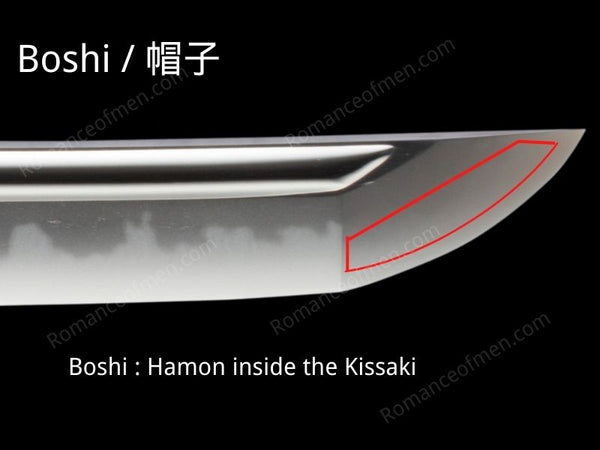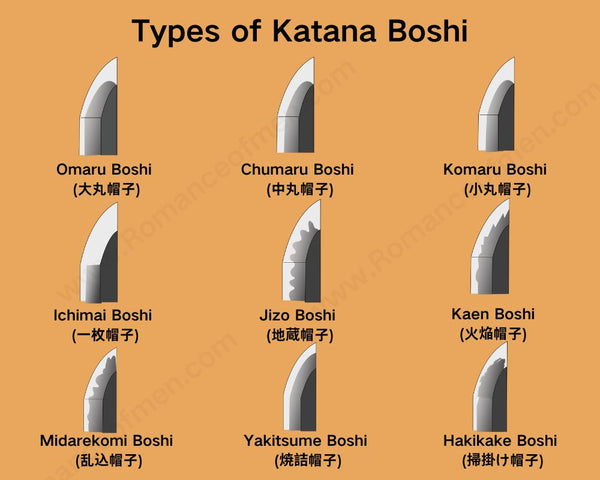Katana Boshi Beauty of this little hamon line within the Kissaki
Everything You Need To Know About Boshi
You can't look at a katana and not be struck by its beauty, despite its function as a lethal weapon. The Katana has a complex anatomy, and many components complete it. Among all the essential elements of a Katana, here I share everything you should know about Boshi.
Table of Content
What Is Boshi (帽子)?

Boshi refers to the Hamon line inside the Kissaki (Tip of the blade). In Japanese, Boshi (帽子 / 鋩子) means hat or cap. This portion of the Hamon is called Boshi because it sits like a hat on the tip of the blade.
Boshi is the hardest part of the Hamon to polish. It is said that the time taken to polish just this portion of the blade is the same as polishing the whole blade. Boshi is the "face" of a Japanese katana, it reveals the condition of the sword, and skill of the swordsmith.
The purpose of Boshi
Many might think that the Boshi was created purely for decorative purposes. While this might be true for modern swords, which are no longer used in actual combat, the Boshi had a practical purpose in ancient Japan. Given that the tip of a katana is frequently used for stabbing, it must be robust and strong. Thus, the presence of the Boshi is not merely ornamental but also a crucial structural feature to enhance the blade's durability and effectiveness.
Let's look at how Kissaki was formed so we will understand better the Boshi:
In traditional katana making, the Kissaki is shaped by hammering, not merely cutting. To form the Kissaki, swordsmiths first make a diagonal cut on the spine (Mune) side, then fold and hammer the blade side to shape the tip.

Understanding this technique is essential: traditional katana blade are constructed with a hard outer layer of steel and a softer inner layer, resembling a sandwich. This design allows for a sharp, durable edge and a flexible spine that prevents breaking.
Cutting the blade side would expose the softer inner steel, compromising the tip's integrity during tempering and increasing breakage risk. By cutting and hammering the spine instead, the hard outer layer is preserved, ensuring a sharp, robust Kissaki that withstands use without weakening.
Kissaki is such an important part of a Katana sword, not only we need a good construction, we also need precise hardening. This is why we said Boshi is important to the functionality of the katana sword, and not just for aesthetic.
In the famous clay tempering process that produce the katana Sori and Hamon, maintaining the ideal temperature (at about 750–760 degrees Celsius) is a difficult task, especially in ancient times without modern technology. Boshi is the smallest part of the katana sword, It is thinner, so it heats up faster and is more likely to break than other parts. Giving Boshi a proper heat treatment is difficult, requires years of experience. That's why for traditional katana, the quality of the Boshi is a significant indicator of the swordsmith's expertise.
Types of Boshi
There are over 20 types of Boshi, Each of these Boshi types reflects specific techniques and aesthetic considerations in the art of Japanese sword-making, here we will introduce the major types:

Omaru Boshi (大丸帽子) - Features a large rounded tip. The Hamon extends from the side towards the tip and curves back at the peak, creating a significant curve. Commonly seen in Kote 古刀.
Chumaru Boshi (中丸帽子) - Characterized by a moderate round curve along the curvature near the tip, giving an elegant and balanced impression. Often found in renowned swords.
Komaru Boshi (小丸帽子) - Known for its smaller round curve at the tip, this type is popular in Shintou 新刀 and features a deeper burn width with a small curve back.
Kaen Boshi (火焔帽子) - Resembles a fiercely burning flame, with the blade spilling forward in a pointed fashion at the tip, giving a dynamic appearance.
Ichimai Boshi (一枚帽子) - Almost the entire tip up to the transverse ridge is hardened, allowing for deep tempering suitable for practical use, especially during the combat-heavy Sengoku period.
Jizo Boshi (地蔵帽子) - Named for its unique shape that resembles a Jizo statue sitting, this type features a significant disturbance in the Hamon near the transverse ridge, leading to a small round curve at the tip.
Yakitsume Boshi (焼詰帽子) - This Boshi has no curvature returning towards the blade's edge, the Hamon flows smoothly towards the spine, typical in reshaped naginata or nagamaki.
Hakikake Boshi (掃掛け帽子) - Features a sweeping effect where the hardening line flows like swept sand towards the tip, giving a blurred, delicate appearance.
Midarekomi Boshi (乱込帽子) - Regardless of whether the Hamon is Suguha (直刃 / Straight ) or Midare (乱刃 / Irregular), this Boshi shows disturbance above the transverse ridge, and its condition is used to judge the alignment and integrity of the tip.
What is the Biggest Flaw of a Boshi You Should Look Out for?
Ans: The most severe problem with Boshi occurs when the temper line comes in contact with the ha or the Blade's edge. The temper line may break off the Blade's edge in a worse situation. If the temper line breaks off the tip, it is no longer regarded as structurally sound and cannot be utilized safely for tip cutting.
For modern steel katana, usually don't need differential hardening process to enhance the blade, hence they don't features Hamon, leave along Boshi. If you want a custom katana made in the traditional way, Boshi is something you can customize.
Conclusion
If you are buying, or just learning about Katanas, having sufficient knowledge about their anatomy is a must. So today, I share with you all that you must know about one of the essential components of a Katana, Boshi. Thanks for reading!





















